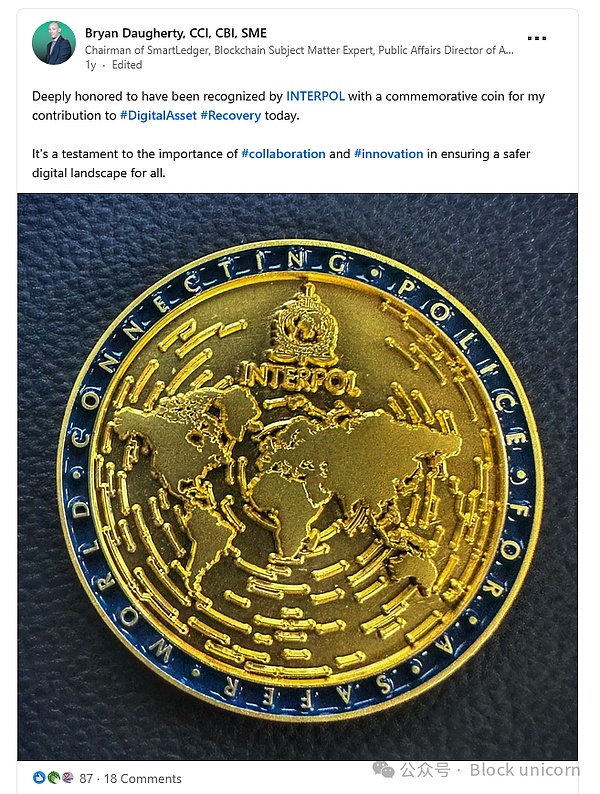
Article Author: Bryan Daugherty Article Compilation: Block unicorn
The U.S. Marshals manage billions of confiscations Bitcoin, but cannot provide the exact number of its holdings. This opacity is more than just a quirk on the accounting—it is a warning sign. Speculations are everywhere about mismanagement, theft or pure incompetence in digital asset tracking. What is the root cause? Old systems: manual recording, fragile supervision mechanisms, and the lack of audit trails that cannot be changed. As discussions on building cryptocurrency reserves heat up, it’s not just a matter of the Marshals — it’s a harbinger of a broader crisis. Traditional methods cannot handle digital assets at scale. Blockchain technology can.
The problem lies: Why traditional systems failLaw enforcement agencies around the world are struggling to deal with the problem of data integrity and coordination failure—I am in the book "Innovative Justice" See it with your own eyes and describe it in detail. The Marshals’ Bitcoin shortage is a clear symptom. Here are the reasons for the collapse of the status quo:
Laboring transparency: The confiscated funds should be traceable, but there is no public account. Manual recording can easily lead to fraud, error or cover-up.
Supervision delay: Traditional databases can be modified quietly. Bitcoin is moving, but the update is lagging behind - making audits an afterthought, not a safeguard.
Security vulnerability: Digital assets require digital priority protection. Without advanced security measures, damaged wallets or internal theft can lead to irreversible loss of funds.
These are not theories. Millions of confiscated Bitcoins have disappeared due to records lost, keys stolen, or lax enforcement. This approach is too risky and cannot continue like this.
Key Issue: Bitcoin Reserves are in the airThe American Dream to Build a Bitcoin Reserve—This It is a brave step towards the crypto era. But ambitions do not mean preparation. The mafia of the Marshals reveals a cruel reality: we cannot trust to manage strategic assets until existing problems are fixed. Trust requires transparency, and we are far from enough at the moment:
Unknown assets: billions ofBitcoin is lost from the cracks. How can we manage a reserve if we cannot track the confiscated funds?
Opaque process: liquidation is carried out behind the scenes—there is no clear record of auctions and transactions. Public trust cannot survive in ambiguous.
Passive reaction system: Loss accumulates without anyone noticing it. Reserves require real-time accountability, not excuses.
A quick move now, there may be another headline news about "billions of losses". Bitcoin’s strength lies in its transparency; reserves built on a shaky foundation will violate that promise – and our credibility.
Solution: Blockchain is the premiseBlockchain is not a buzzword—it is a proven tool of transparency and security, as I did in " as discussed in the Innovative Justice and the Standard Operating Procedure for Investigating Crime Crime (TBR). Here is how it changes the management of confiscated assets:
Improper traceability: Every The confiscated bitcoins are recorded on the blockchain—whether public or licensed—with an encrypted ID. Auditors, courts and citizens can verify holdings instantly. There is no longer "lost" funds.
Fraud prevention wallet: Multi-signature wallets and smart contracts require multiple approvals (such as the Marshals, Ministry of Justice, and supervisory agencies) to move assets. A malicious actor cannot move a penny. Automatic alerts will mark any attempts.
Transparent liquidation: Forgot the opaque auction. On-chain sales associate each transaction with its case, verify the buyer through smart contracts, and transfer the proceeds directly to the account – no middlemen, no mystery.
This is not optional—this is the first step. Only by proving that we can handle confiscation of assets transparently, reserves become feasible. Skip this step and we are building on the sand.
The moment of action is now—but haste is the enemy
The United States can have digital assetsLead the world in management – or fall as losses keep increasing. Technology already exists. Needs are urgent. But rushing to launch Bitcoin reserves before mastering the basics will only lead to failure. Blockchain provides decentralization, immutability and trust—the qualities that define the value of cryptocurrencies. Law enforcement agencies and relevant departments must adopt it to rebuild confidence, starting with the confiscation of assets.
We are not ready to build reserves until transparency becomes a non-negotiable condition. The failure of the Marshals Department proves this. Time is tight – but in the digital age, what determines our future is ability, not speed.












